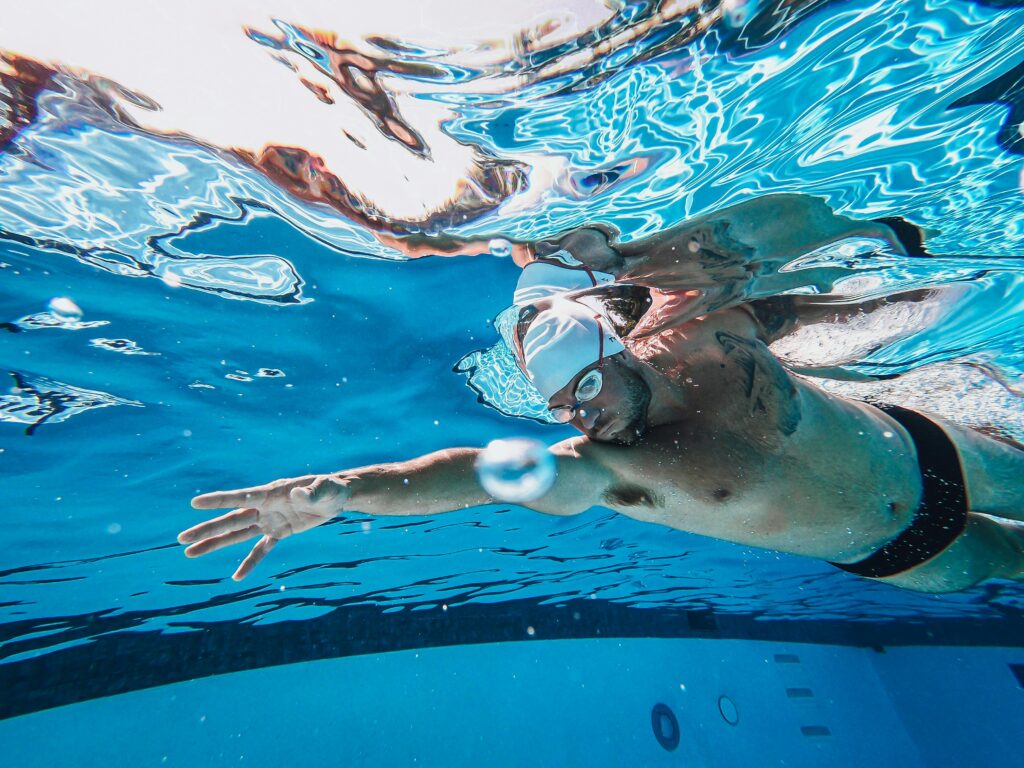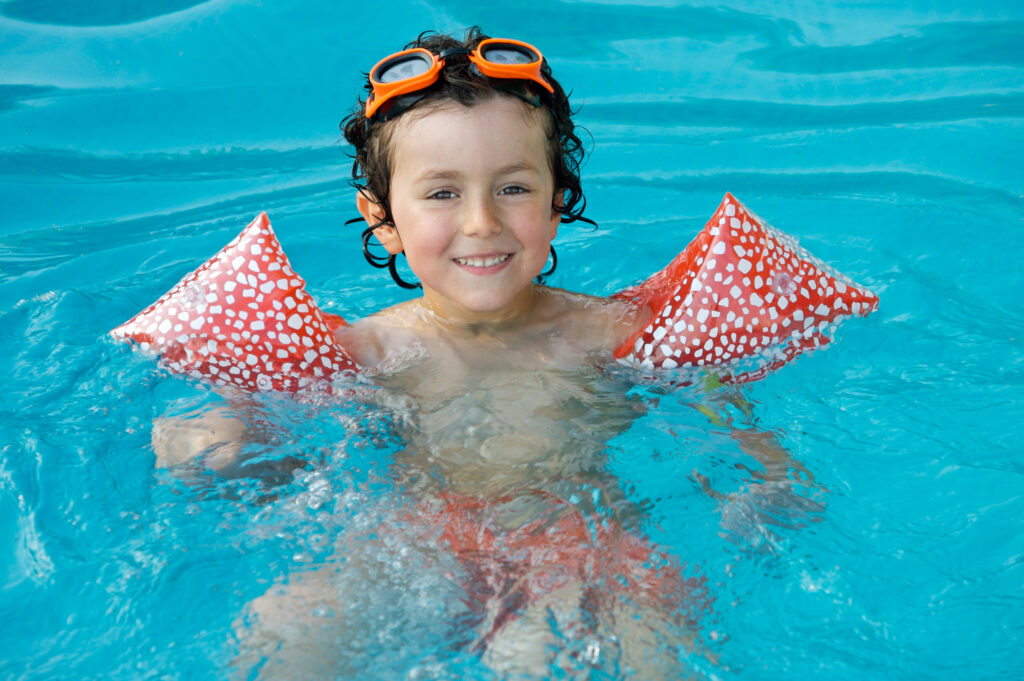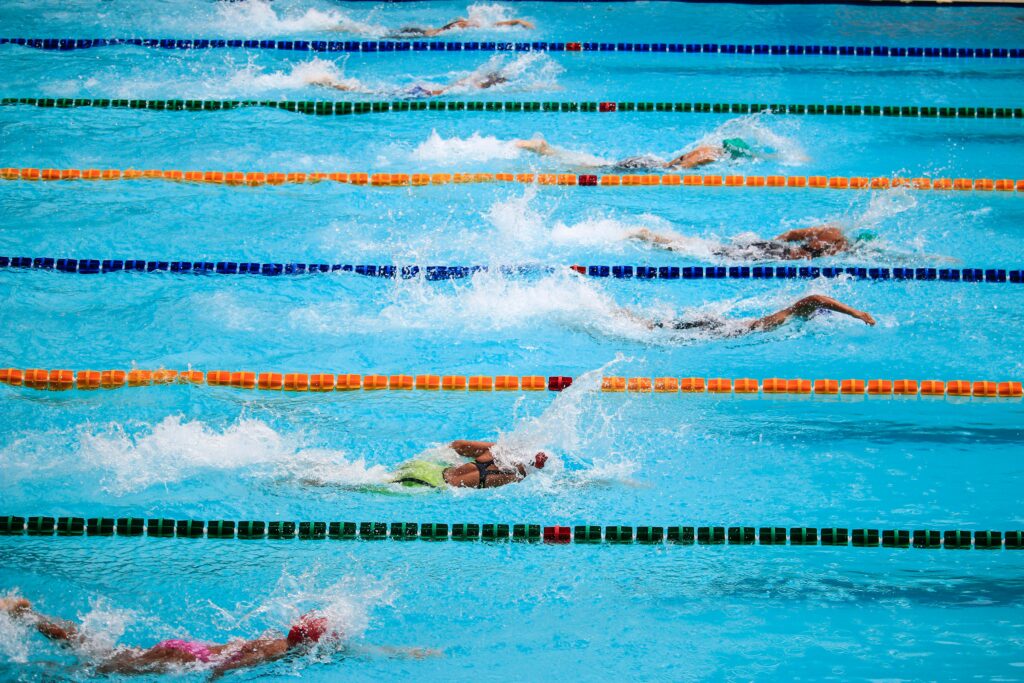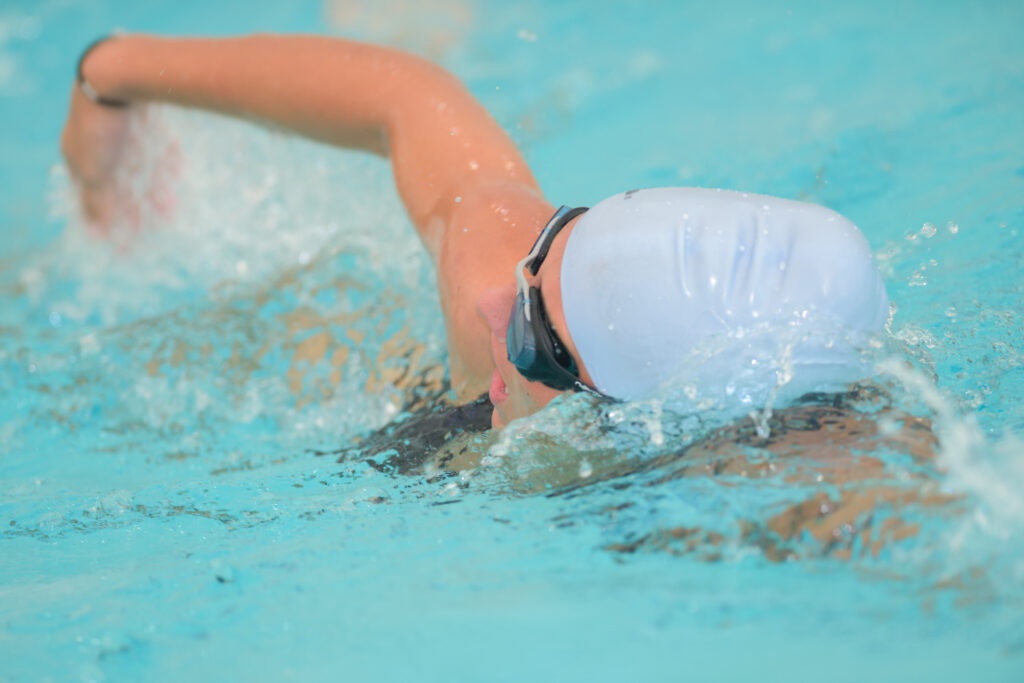Looking to maximise your calorie burn in the pool? Swimming is a fantastic full-body workout that can help with weight loss while being gentle on the joints. Each stroke engages different muscle groups and burns calories at varying rates.
The butterfly stroke burns the most calories, with an average of 450 calories in just 30 minutes of swimming. This challenging stroke requires significant upper body strength and proper technique, making it the most demanding of all swimming strokes. The butterfly’s intensity comes from the simultaneous arm movement and dolphin kick that propels swimmers through the water.
For those who find butterfly too challenging, front crawl (freestyle) offers the next best calorie burn. It’s more accessible for regular swimmers whilst still providing an excellent workout. Regardless of which stroke you choose, consistent swimming sessions can contribute significantly to your fitness goals and overall health.
Understanding Calories Burnt in Swimming
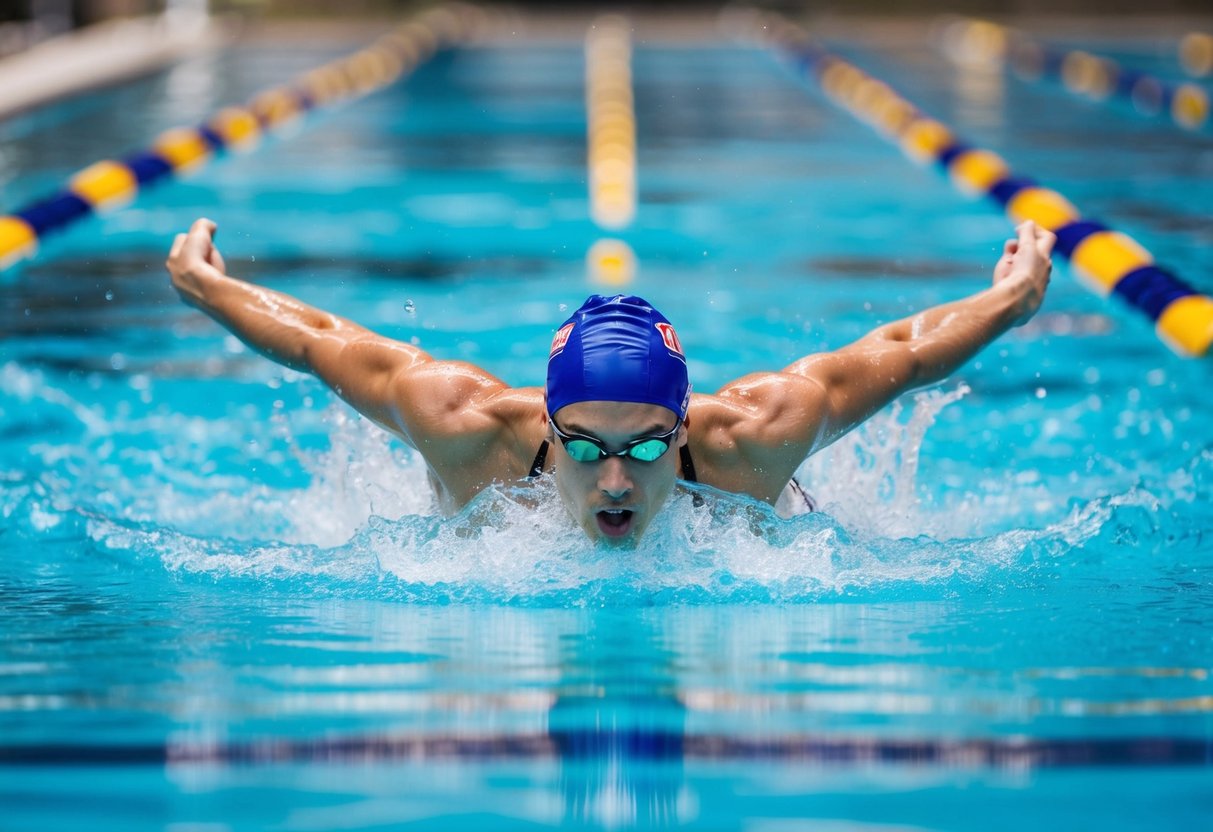
Swimming can be an effective way to burn calories and improve fitness. The number of calories you use during a swim depends on several factors, including which stroke you choose and how intensely you swim.
The Role of Cardio in Weight Loss
Cardiovascular exercise like swimming is essential for weight loss because it increases your heart rate and burns calories. When you swim, your body works against water resistance, which can be 12 times greater than air resistance.
Your body burns calories to provide energy for movement. The more effort required, the more calories you use. Swimming engages multiple muscle groups simultaneously, making it an efficient calorie-burning activity.
For weight loss, consistency matters more than intensity. Regular swimming sessions of 30 minutes can create the calorie deficit needed to lose weight gradually.
Research shows that swimming can burn between 200-450 calories per 30-minute session, depending on the stroke and effort level.
Caloric Expenditure of Different Strokes
Different swimming strokes require varying levels of energy and therefore burn different amounts of calories:
- Butterfly – Burns approximately 450 calories per 30 minutes, making it the most demanding stroke. It requires powerful, simultaneous arm movements and a dolphin kick.
- Front Crawl (Freestyle) – Burns about 350 calories per 30 minutes. It’s efficient and sustainable for longer distances.
- Breaststroke – Burns around 300 calories per 30 minutes. Though slower, it’s accessible for beginners.
- Backstroke – Burns approximately 250 calories per 30 minutes. It’s excellent for improving posture and reducing back pain.
The butterfly stroke is the champion at blasting calories due to its forceful movements and the significant energy required to lift your body out of the water.
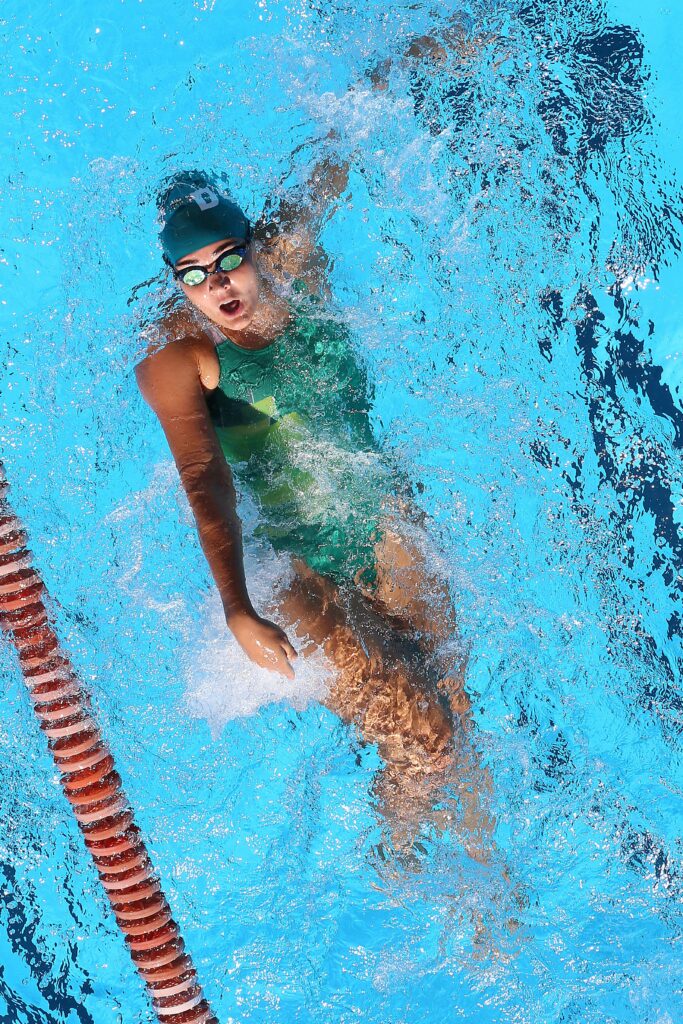
Swimming as Aerobic Exercise
Swimming qualifies as excellent aerobic exercise because it elevates your heart rate sustainably without excessive strain on joints. Unlike running or high-impact activities, swimming distributes weight evenly and reduces injury risk.
The aerobic nature of swimming helps improve cardiovascular health by strengthening your heart and lungs. Regular swimmers typically develop greater lung capacity and respiratory efficiency.
Swimming in cooler water may increase calorie burn slightly as your body works to maintain core temperature. This thermogenic effect adds to the overall energy expenditure during your swim session.
For maximum aerobic benefit, aim for 2-3 swimming sessions weekly, each lasting 30-45 minutes. Interval training—alternating between high-intensity strokes like butterfly and recovery periods—can further enhance calorie burn and cardiovascular fitness.
Detailed Analysis of Swimming Strokes
Different swimming strokes engage distinct muscle groups and require varying levels of energy expenditure, directly impacting the number of calories burned during a swimming session.
Breaststroke: Technique and Calorie Burn
Breaststroke ranks as the second most calorie-intensive stroke, burning approximately 400 calories in a 30-minute session. This traditional stroke works multiple muscle groups simultaneously, particularly the chest, shoulders and inner thighs.
The frog-like leg movement requires significant energy, making it an effective choice for those seeking substantial calorie burn without the technical difficulty of butterfly.
Breaststroke offers these key benefits for calorie burning:
- Lower impact on shoulders than other strokes
- Excellent for toning the chest and legs
- Can be maintained for longer periods than butterfly
- Burns 60-70% more calories than walking
Many swimmers find breaststroke accessible yet challenging enough to maintain an elevated heart rate throughout their workout.
Backstroke: Benefits for Calories Torching
Backstroke provides a moderate calorie burn of approximately 250-350 calories per half hour, making it less intensive than butterfly or breaststroke but still an effective option for weight management.
The supine position creates unique advantages for extended training sessions. By reducing neck and back strain, swimmers can maintain backstroke for longer periods, potentially increasing overall calorie expenditure.
Backstroke particularly engages these muscle groups:
- Core stabilisers
- Shoulder rotators
- Latissimus dorsi
- Hamstrings
While not the highest in terms of immediate calorie burn, backstroke offers excellent sustainability for longer workouts. This makes it particularly valuable for those building swimming endurance while still wanting significant energy expenditure.
Butterfly: Intensity and Total Body Burn
Butterfly stroke stands as the undisputed champion for calorie burning, torching an impressive 450-500 calories in just 30 minutes. This demanding stroke requires coordinated movement of the entire body, creating an intensive full-body workout.
The powerful dolphin kick combined with the simultaneous arm recovery demands exceptional core strength and cardiovascular fitness. Even competitive swimmers find butterfly challenging due to its heightened energy requirements.
Butterfly delivers these calorie-burning advantages:
- Maximum muscle engagement across the body
- Highest heart rate elevation of all strokes
- Significant upper body strengthening
- Intense core activation
The stroke’s difficulty represents both its greatest strength and limitation—while burning the most calories, many swimmers struggle to maintain butterfly for extended periods, potentially reducing total workout duration.
Freestyle: The Fast Track to Calorie Deficit
Freestyle (front crawl) delivers excellent calorie-burning efficiency, using approximately 300-400 calories per 30 minutes of swimming. Its streamlined movement pattern allows swimmers to maintain a higher pace than most other strokes.
The alternating arm movement and flutter kick create a balanced full-body workout that particularly engages the shoulders, core and legs. Freestyle’s relative technical accessibility makes it practical for sustained training sessions.
Key factors influencing freestyle’s calorie burn include:
- Swimming speed (faster pace = higher burn)
- Kick intensity
- Stroke efficiency
- Overall fitness level
For many swimmers, freestyle offers the optimal balance between calorie expenditure and sustainability. While not matching butterfly’s peak intensity, the ability to maintain freestyle for longer durations often results in greater total calorie deficit over complete swimming sessions.
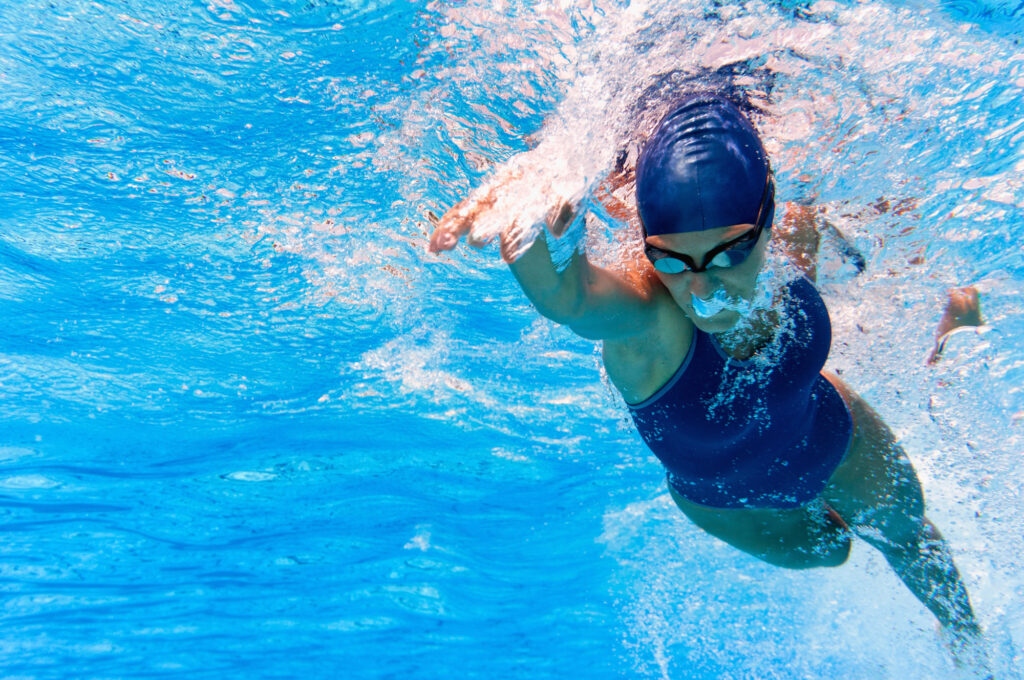
Benefits of Swimming for Overall Fitness
Swimming offers excellent total-body conditioning while being gentle on joints. It combines cardiovascular improvements with resistance training, making it an ideal exercise for people of all fitness levels.
Improving Cardiovascular Workouts
Swimming provides exceptional benefits for your heart and lungs. When you swim regularly, your heart becomes stronger and more efficient at pumping blood throughout your body.
Research indicates that just 30 minutes of swimming can burn between 400-500 calories, depending on the stroke used, with butterfly burning the most calories per session. This high calorie burn contributes to improved cardiovascular health.
Swimming also lowers blood pressure and reduces stress on the cardiovascular system. Unlike high-impact exercises, swimming minimises stress on joints whilst still providing an intense workout.
Different strokes challenge the cardiovascular system in unique ways. The front crawl often shows excellent results for cardiovascular conditioning, whilst the butterfly stroke creates the highest oxygen demand.
Enhancing Endurance and Strength
Swimming builds muscular endurance and strength throughout the entire body. Water provides natural resistance that’s 12-14 times greater than air, turning every movement into a strength-training exercise.
The different swimming strokes target various muscle groups:
- Butterfly: Shoulders, chest, upper back
- Breaststroke: Inner thighs, chest, shoulders
- Front crawl: Core, shoulders, back
- Backstroke: Shoulder blades, back muscles, core
Regular swimming improves lung capacity and breathing efficiency. Swimmers develop controlled breathing patterns, which can increase oxygen delivery to muscles and enhance overall performance.
This improved oxygen efficiency translates to better endurance in other physical activities. Many athletes incorporate swimming into their training regimens specifically to build stamina without risking injury.
Reduction of Belly Fat through Routine Swimming
Swimming effectively targets visceral fat, particularly around the midsection. The combination of cardio and resistance training creates an ideal environment for fat burning.
A consistent swim routine of 3-4 sessions per week, lasting at least 30 minutes each, shows significant results in reducing waist circumference. All swimming strokes work different muscle groups, creating a comprehensive approach to burning belly fat.
The butterfly stroke, whilst challenging, offers the highest calorie burn, with studies showing it can burn approximately 450 calories in 30 minutes. This makes it particularly effective for targeting stubborn abdominal fat.
Water’s cooling effect also prevents overheating during extended workouts, allowing for longer, more effective fat-burning sessions. Additionally, swimming reduces stress hormones like cortisol that contribute to belly fat accumulation.
Incorporating Swimming into a Weight Loss Plan
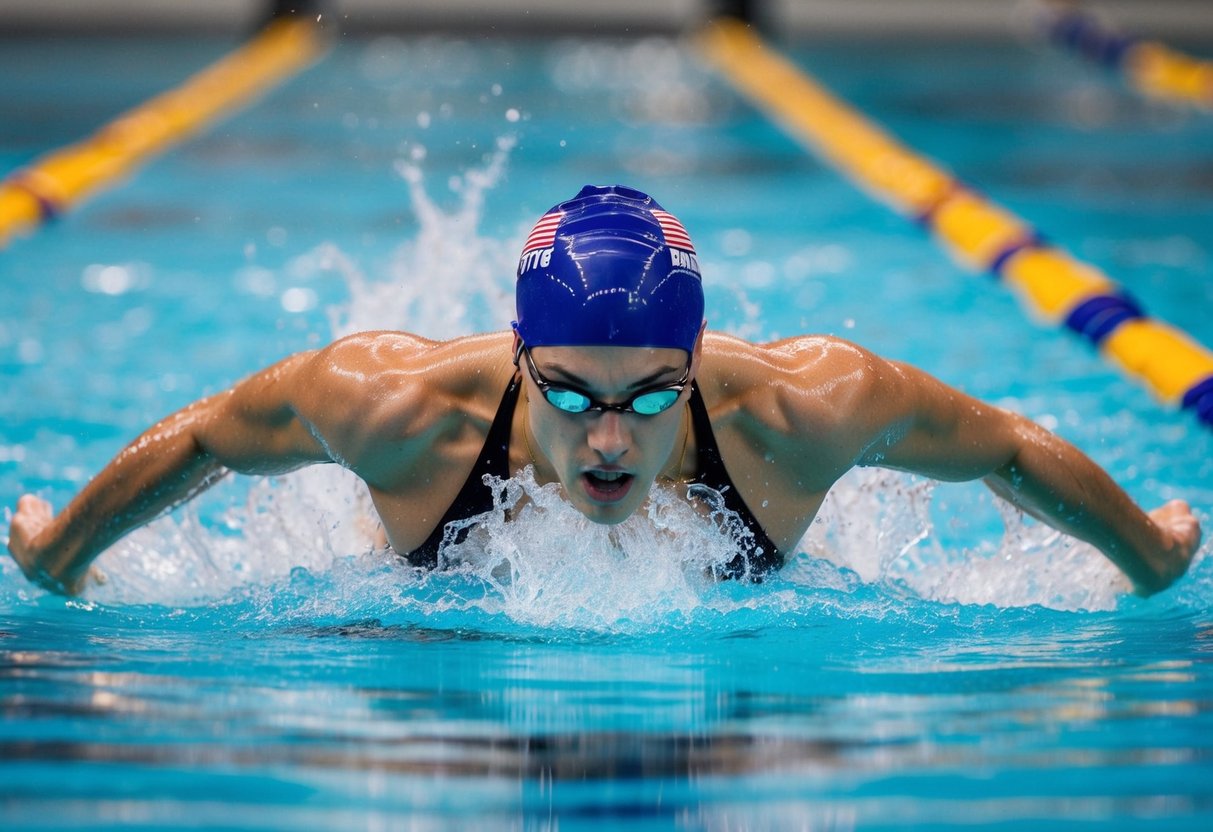
Swimming offers an excellent path to weight loss with its full-body workout and calorie-burning potential. When properly structured, swim sessions can become a cornerstone of an effective fitness programme that helps shed unwanted pounds.
Strategies for A Swimming-Based Fitness Regime
To maximise calorie burn while swimming, focus on intensity and variety. Butterfly stroke burns approximately 450 calories in a 30-minute session, making it the most effective for weight loss. Front crawl follows closely behind, with breaststroke and backstroke still offering substantial calorie burn.
Interval training proves particularly effective. Try swimming hard for 1-2 lengths, then recover with 1 length at a moderate pace. Repeat this pattern for 20-30 minutes to boost metabolism and increase fat burning.
Gradually increase session duration as your fitness level improves. Begin with 20-minute workouts and work up to 45-60 minutes three times weekly for optimal results.
Using equipment like pull buoys, kickboards and hand paddles can target specific muscle groups and add variety to workouts.
Creating a Consistent Swim Workout Schedule
Consistency is crucial for swimming-based weight loss. Aim for 3-4 swim sessions weekly, allowing rest days between for muscle recovery.
Schedule swims at times that work reliably with your routine—whether early mornings before work or evenings after. Many find that booking specific lane-swimming times helps maintain commitment.
Track progress to stay motivated. Note distance covered, time spent swimming, and how you feel after each session. Many fitness watches now offer waterproof options for precise monitoring.
Mix stroke types within sessions to prevent boredom and work different muscle groups. A simple plan might include:
- Monday: Endurance (steady pace for longer distances)
- Wednesday: Interval training (sprint and recovery periods)
- Friday: Technique focus (slower pace with attention to form)
Complementing Swimming with a Healthy Diet
Swimming stimulates appetite, so dietary choices become especially important. A fat-burning swimming workout can burn around 300 calories in 20-25 minutes, but poor food choices can quickly negate this effort.
Focus on protein-rich foods after swimming to support muscle recovery. Lean meats, fish, eggs and plant proteins help rebuild muscle tissue worked during swimming.
Time your meals strategically. Eat a light, carbohydrate-based snack 30-60 minutes before swimming for energy. After swimming, consume protein within 30 minutes to optimise recovery.
Stay hydrated! Despite being surrounded by water, swimmers often become dehydrated. Drink water before, during (keep a bottle poolside) and after sessions.
Reduce processed foods and refined sugars while increasing intake of fresh vegetables, fruits and whole grains to complement your swimming routine for maximum weight loss results.

Essential Swimming Techniques and Practices
Proper swimming technique affects both performance and calorie burn. Mastering correct form and preparation allows swimmers to maximise efficiency while achieving their fitness goals.
Mastering Swimming Techniques for Efficiency
Each stroke requires specific technique to achieve maximum efficiency. For the butterfly stroke, which burns the most calories, proper body undulation is crucial. The movement should originate from the chest, flowing through the hips in a wave-like motion.
The breaststroke, the second most calorie-intensive stroke, demands precise timing. The frog kick must be synchronised with arm movements for optimal propulsion. Keep your knees shoulder-width apart during the kick and avoid bringing them too far up towards your chest.
For front crawl efficiency:
- Keep your body position flat and aligned
- Rotate from the core, not just the shoulders
- Enter hands into water at a 45-degree angle
- Maintain a consistent six-beat kick
Remember that proper technique not only increases calorie burn but also reduces injury risk.
Breathing Technique and Its Impact on Performance
Breathing technique significantly affects swimming performance and calorie expenditure. For front crawl, turn your head to breathe rather than lifting it, keeping one eye below the waterline. This maintains proper body position and reduces drag.
The butterfly stroke requires precise breathing timing – inhale quickly when your head naturally rises during the stroke cycle. Breaststroke allows for more relaxed breathing as your head stays above water longer.
Bilateral breathing (breathing on both sides) during front crawl helps develop balanced muscles and technique. Practice breathing every three strokes to develop this skill.
Breathing pattern by stroke:
| Stroke | Ideal Pattern | Common Mistake |
|---|---|---|
| Butterfly | Every 2 strokes | Lifting head too high |
| Breaststroke | Every stroke | Not exhaling underwater |
| Front Crawl | Every 3 strokes | Rotating too far |
The Importance of an Aerobic Warm-Up
An aerobic warm-up is essential before attempting high-intensity swimming. Begin with 5-10 minutes of gentle swimming using a comfortable stroke to gradually increase heart rate and blood flow to muscles.
Dynamic stretching helps prepare muscles for the demands of swimming. Include arm circles, trunk rotations and gentle neck stretches poolside before entering the water.
Incorporate technique drills into your warm-up. For example, if planning a butterfly-focused session for maximum calorie burn, include butterfly drills that isolate key components:
- Single-arm butterfly pulls
- Butterfly kicks with a kickboard
- Two kicks, one pull drill
A proper warm-up not only prevents injury but also enhances performance during the main workout. This preparation is particularly important for demanding strokes like butterfly, which can burn approximately 450 calories per 30 minutes of sustained effort.
Additional Tools and Resources
Beyond choosing the right stroke, several tools and equipment can enhance your calorie-burning potential. Digital resources can also provide valuable guidance for maximising your swimming workout efficiency.
Optimising Swim Gear for Maximum Calorie Burning
The right swim gear can significantly impact calorie burn during your swimming sessions. Resistance gloves and hand paddles increase water resistance, forcing muscles to work harder and burn more calories. These accessories are particularly effective when doing butterfly stroke, which already burns around 450 calories per 30-minute session.
Drag suits and resistance bands also create more challenging swimming conditions. This added difficulty increases heart rate and calorie expenditure, even when swimming at slower speeds.
Essential calorie-burning swim gear:
- Resistance gloves/paddles
- Drag suits/shorts
- Pull buoys (for targeted upper body workouts)
- Kickboards (for focused leg training)
- Swim fins (for ankle flexibility and kick strength)
Utilising Online Platforms like Yahoo for Swimming Tips
Online resources provide valuable information on optimising swimming techniques for weight loss. Yahoo’s health and fitness sections often feature articles from swimming experts about stroke efficiency and calorie-burning workouts.
Swimming forums and dedicated swimming websites offer workout plans specifically designed for calorie burning. These typically combine high-intensity intervals of butterfly or front crawl with recovery periods using breaststroke.
Many platforms provide video tutorials demonstrating proper technique for the butterfly stroke, which experts consider the most challenging and calorie-intensive swim style.
Tracking apps compatible with waterproof fitness devices can monitor heart rate, lap count and estimated calories burned during swimming sessions, allowing for better workout optimisation over time.
Frequently Asked Questions
Swimming offers varied calorie-burning potential across different strokes. The technique, intensity, and individual factors all influence how many calories you’ll burn during your swim session.
Which swimming stroke is most effective for burning calories?
The butterfly stroke burns the most calories of all swimming styles. This challenging stroke can help you burn approximately 450 calories in just 30 minutes of swimming.
The intense full-body movement required for butterfly makes it particularly effective for calorie expenditure.
Front crawl (freestyle) ranks second for calorie burning, while backstroke and breaststroke follow with progressively lower energy expenditure.
What is the best swimming style to target abdominal fat reduction?
All swimming strokes engage the core muscles, making swimming excellent for overall fat reduction rather than spot reduction.
Butterfly and front crawl particularly activate the abdominal muscles as they require significant core stabilisation throughout the stroke.
For best results, incorporate a mix of strokes with proper technique to engage all core muscle groups whilst maintaining a calorie deficit through consistent swimming sessions.
How does the butterfly stroke compare to other strokes in terms of calorie expenditure?
Butterfly significantly outperforms other strokes for calorie burning, with estimates of 400-500 calories burned in a 30-minute session.
Front crawl typically burns about 300-400 calories per half hour, while backstroke averages 250-350 calories in the same timeframe.
Breaststroke generally burns the fewest calories among the main strokes but still provides an excellent cardiovascular workout.
How can I calculate the calories I burn while swimming different distances?
Calorie expenditure whilst swimming depends on several factors including body weight, swimming efficiency, stroke type, and intensity.
Most fitness trackers and swimming watches can estimate calorie burn based on these variables, though their accuracy varies.
As a general rule, multiply your weight in kilograms by the MET value of your chosen stroke (butterfly: 9.8, freestyle: 8.3, backstroke: 8, breaststroke: 5.3) and then by duration in hours to estimate calories burned.
Which swimming stroke is optimal for muscle toning and building strength?
Butterfly provides the most comprehensive full-body workout, engaging shoulders, arms, core, and legs simultaneously with significant resistance.
Breaststroke particularly targets the pectoral muscles, shoulders, and inner thighs, making it excellent for lower body toning.
Front crawl builds upper body strength, especially in the shoulders, back, and arms, while backstroke helps improve posture by strengthening the posterior chain muscles.
Among the various swimming strokes, which is the least efficient for calorie burning?
Breaststroke typically burns the fewest calories of the main swimming strokes, averaging about 250 calories per 30 minutes of swimming.
This lower calorie burn is due to the more relaxed nature of the stroke and less overall body movement compared to butterfly or front crawl.
Despite burning fewer calories, breaststroke remains an excellent low-impact exercise option, particularly for beginners or those with joint issues.

